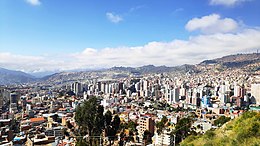Cardoza
Cardoza | |
|---|---|
Capital City | |
| Federal Capital of Paraboca | |
Clockwise from top left: Cardoza Skyline with Mount Acadagua in the background, Cardoza-La Alta cable car, Congress of Paraboca, Downtown Cardoza, Banco Federal De Paraboca, San Francisco Church | |
| Country | Paraboca |
| State | Federal Capital |
| Population (2018) | |
| • Capital City | 4,502,993 |
| • Urban | 8,321,000 |
Cardoza is the capital city and largest city of Paraboca. It is Paraboca's largest and most populous city as well as the nation's political and administrative center. Cardoza is host to foreign embassies and consulates. It is the home base of several state-owned entities such as PNGE and Banorte, the national energy and banking companies, respectively. The city is also home to the country's most important public university, the University of Paraboca, as well as the national soccer team. The capital's international airport is known for its short runway and the unusual maneuvers pilots must undertake upon landing or taking off to avoid the nearby mountains. Cardoza is at an average elevation of 1,680 metres (5,510 feet) above sea level. The city is known as the "Fruit Garden of Paraboca," due to the numerous fruit orchards in and around it, and the large variety of fruits and dried fruit products produced there.
Cardoza is known for its rich culture and history. It has served as Paraboca's capital since 1573. It was occupied by Zamastanian and Chanchajillan forces after the end of the Parabocan War from 1876-78. The city experienced extensive and largely unstained population growth after the Ledyanaya War ended, but modernization after Jamie Bolivar's dictatorship collapsed in 1959 led to the city becoming more of an economic and cultural center that it is known as today. The city is considered to be an international city due to its prominence in global economy and interconnectedness, and is generally thought to be the most important city in Central Euronia.
It is in a bowl-like depression, part of the Central Euronia basin, surrounded by the high Asarana Mountains. Overlooking the city is the towering, triple-peaked Acadagua, which at a height of 6,959 m (22,831 ft) makes it the tallest peak on Euronia and the fourth-tallest in the world. Its peaks are always snow-covered and can be seen from many parts of the city. At an elevation of roughly 3,650 m (11,975 ft) above sea level, Cardoza is the highest capital city in the world. Due to its altitude, Cardoza has an unusual subtropical highland climate, with rainy summers and dry winters.





